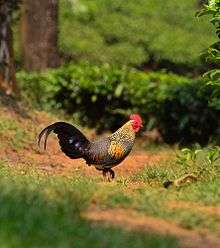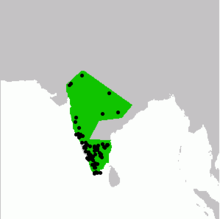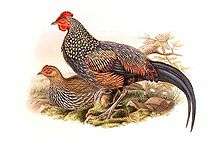Grey junglefowl
| Grey junglefowl | |
|---|---|
 | |
| Male, Munnar | |
.jpg) | |
| Female, Thattekad Bird Sanctuary | |
| Scientific classification | |
| Kingdom: | Animalia |
| Phylum: | Chordata |
| Class: | Aves |
| Order: | Galliformes |
| Family: | Phasianidae |
| Subfamily: | Phasianinae |
| Genus: | Gallus |
| Species: | G. sonneratii |
| Binomial name | |
| Gallus sonneratii Temminck, 1813 | |
 | |
| Actual spot records and presumed distribution | |
The grey junglefowl (Gallus sonneratii), also known as Sonnerat's junglefowl, is one of the wild ancestors of domestic fowl together with the red junglefowl and other junglefowls.
The grey junglefowl is responsible for the yellow pigment in the legs and different body parts of all the domesticated chicken.[2]
This species is endemic to India, and even today it is found mainly in peninsular India and towards the northern boundary. It will sometimes hybridize in the wild with the red junglefowl. It also hybridizes readily in captivity and sometimes with free-range domestic fowl kept in habitations close to forests.
The species epithet commemorates the French explorer Pierre Sonnerat. Local names include Komri in Rajasthan, Geera kur or Parda komri in Gondi, Jangli Murghi in Hindi, Raan kombdi in Marathi, Kattu Kozhi in Tamil and Malayalam, Kaadu koli in Kannada and Tella adavi kodi in Telugu.[3]
Description

The male has a black cape with ochre spots and the body plumage on a grey ground colour is finely patterned. The elongated neck feathers are dark and end in a small, hard, yellowish plate; this peculiar structure making them popular for making high-grade artificial flies.[4] The male has red wattles and combs but not as strongly developed as in the red junglefowl. Legs of males are red and have spurs while the yellow legs of females usually lack spurs.[5][6] The central tail feathers are long and sickle shaped. Males have an eclipse plumage in which they moult their colourful neck feathers in summer during or after the breeding season.[7]
The female is duller and has black and white streaking on the underparts and yellow legs.
They are found in thickets, on the forest floor and open scrub. Their loud calls of Ku-kayak-kyuk-kyuk (![]() Call of male
Call of male ![]() Other calls
Other calls ![]() calls ) are loud and distinctive, and can be heard in the early mornings and at dusk. Unlike the red junglefowl, the male does not flap its wing before uttering the call.[8] They forage in small mixed or single sex groups. They breed from February to May.[5] They lay 4 to 7 eggs which are pale creamy in a scrape. Eggs hatch in about 21 days. Although mostly seen on the ground, grey junglefowl fly into trees to escape predators and to roost.
calls ) are loud and distinctive, and can be heard in the early mornings and at dusk. Unlike the red junglefowl, the male does not flap its wing before uttering the call.[8] They forage in small mixed or single sex groups. They breed from February to May.[5] They lay 4 to 7 eggs which are pale creamy in a scrape. Eggs hatch in about 21 days. Although mostly seen on the ground, grey junglefowl fly into trees to escape predators and to roost.
They feed on grains including bamboo seeds, berries, insects and termites, and are hunted for meat and for the long neck hackle feathers that are sought after for making fishing lures.
Disputed sub-species
The populations from the Mt. Abu region of Rajasthan named as subspecies wangyeli is usually not recognized[9] although it is said that the calls of the cock from this region differs from the call of birds from southern India and the plumage is much paler.[10]
Distribution
The species is mainly in the Indian Peninsula but extends into Gujarat, Madhya Pradesh and south Rajasthan. This species and the red junglefowl overlap slightly along the northern boundary of the distribution[5] although the ranges are largely non-overlapping.[10] Grey junglefowl have been bred domestically in England since 1862[11] and their feathers have been commercially supplied from domestic UK stocks for fly tying since 1978.[11]

The grey junglefowl is found mostly in Peninsular India, while the red junglefowl is found more along the foothills of the Himalayas. A region of overlap occurs in the Aravalli range.
The species has been isolated by a variety of mechanisms including behavioural differences and genic incompatibility but hybridization is not unknown.[12][13] Some phylogenetic studies of junglefowl show that this species is more closely related to the Sri Lankan junglefowl Gallus lafayetii than to the red junglefowl, Gallus gallus[14] but another study shows a more ambiguous position due to hybridization.[15] An endogenous retroviral DNA sequence, of the EAV-HP group noted in domestic fowl is also found in the genome of this species pointing to the early integration of the virus DNA into the genome of Gallus.[16]
Endangered species
A study in southern India found a density of 19.8 groups per square kilometer (but ranging from 1.67 to 34.42 in dry deciduous forests on plains) with an average group size of 1.3. The male to female ratio was 1:1.2 and the preferred habitat was low to moderate canopied forest with low or no grass cover.[17]
They are threatened by hunting for food and habitat loss. Feather use in fly-fishing has also been suggested as a threat.[18]
References
- ↑ BirdLife International (2012). "Gallus sonneratii". IUCN Red List of Threatened Species. Version 2013.2. International Union for Conservation of Nature. Retrieved 26 November 2013.
- ↑ "Darwin Was Wrong About Wild Origin Of The Chicken, New Research Shows". sciencedaily.com.
- ↑ Anonymous (1998). "Vernacular Names of the Birds of the Indian Subcontinent" (PDF). Buceros. 3 (1): 53–109.
- ↑ "Identification Notes" (PDF). US Fish and Wildlife.
- 1 2 3 Rasmussen PC; JC Anderton (2005). Birds of South Asia: The Ripley Guide. Volume 2. Smithsonian Institution and Lynx Edicions. p. 132.
- ↑ "Occurrence of spurs in the female junglefowl (Gallus sonnerati)". J. Bombay Nat. Hist. Soc. 52 (2–3): 603–604. 1954.
- ↑ Morejohn, G. V. (1968). "Study of the plumage of the four species of the genus Gallus". The Condor. 70 (1): 56–65. doi:10.2307/1366508. JSTOR 1366508.
- ↑ Finn, Frank (1911). The game birds of India and Asia. Thacker, Spink and Co., Calcutta. pp. 21–23.
- ↑ Storer, RW (1988). Type Specimens of Birds in the Collections of the University of Michigan Museum of Zoology (PDF). University of Michigan, Miscellaneous publications No. 174.
- 1 2 Ali S; SD Ripley. Handbook of the birds of India and Pakistan. Volume 2 (2nd ed.). Oxford University Press. pp. 106–109.
- 1 2 Bransford Game Fisheries. "Jungle Cock". Bransford Game Fisheries. Fisherman's feathers. Retrieved 28 September 2013.
- ↑ Eriksson J, Larson G, Gunnarsson U, Bed'hom B, Tixier-Boichard M, et al. (2008). Georges M, ed. "Identification of the Yellow Skin Gene Reveals a Hybrid Origin of the Domestic Chicken". PLoS Genetics. 4 (2): e1000010. doi:10.1371/journal.pgen.1000010.
- ↑ Morejohn, G. Victor (1968). "Breakdown of Isolation Mechanisms in Two Species of Captive Junglefowl (Gallus gallus and Gallus sonneratii)". Evolution. 22 (3): 576–582. doi:10.2307/2406881. JSTOR 2406881.
- ↑ Fumihito, Akishinonomiya; Tetsuo Miyake, Masaru Takada, Ryosuke Shingut, Toshinori Endo, Takashi Gojobori, Norio Kondo & Susumu Ohno (1996). "Monophyletic origin and unique dispersal patterns of domestic fowls" (PDF). Proc. Natl. Acad. Sci. 93 (13): 6792–6795. doi:10.1073/pnas.93.13.6792. PMC 39106
 . PMID 8692897.
. PMID 8692897. - ↑ Nishibori, M.; Shimogiri, T.; Hayashi, T.; Yasue, H. (2005). "Molecular evidence for hybridization of species in the genus Gallus except for Gallus varius". Animal Genetics. 36 (5): 367–375. doi:10.1111/j.1365-2052.2005.01318.x. PMID 16167978.
- ↑ Sacci, MA; K Howes; K Venugopal (2001). "Intact EAV-HP Endogenous Retrovirus in Sonnerat's Jungle Fowl" (PDF). Journal of Virology. 75 (4): 2029–2032. doi:10.1128/JVI.75.4.2029-2032.2001. PMC 115153
 . PMID 11160706.
. PMID 11160706. - ↑ Sathyakumar, S (2006). "Habitat use by grey junglefowl Gallus sonneratii Temminck at Mundanthurai Plateau, Tamil Nadu". J. Bombay Nat. Hist. Soc. 103 (1): 57–61.
- ↑ Wayre,P (1976). "Sonnerat's – a junglefowl threatened by fishermen". Newsletter for Birdwatchers. 16 (5): 1–3.
Other sources
- Tehsin,Raza H (1988) Inducing sleep in birds. J. Bombay Nat. Hist. Soc. 85(2):435-436.
- Chitampalli,MB (1977) Occurrence of Grey Junglefowl and Red Junglefowl together. J. Bombay Nat. Hist. Soc. 74(3):527.
- Abdulali,Humayun (1957) The Grey Junglefowl in Salsette. J. Bombay Nat. Hist. Soc. 54(4):946.
- Tehsin,Raza; Tehsin,Fatema (1990) Jungle Cat Felis chaus and Grey Junglefowl Gallus sonneratii. J. Bombay Nat. Hist. Soc. 87(1):144.
- Morris,RC (1927) A jungle fowl problem. J. Bombay Nat. Hist. Soc. 32(2):374.
- Sethna, KR (1969). "Grey Junglefowl in South India". Newsletter for Birdwatchers. 9 (11): 10.
- Ali,S (1968) The case of the Indian Grey Junglefowl. Newsletter for Birdwatchers . 8(5):5-6.
- Subramanian,C; Kambarajan,P; Sathyanarayana,MC (2001) Roosting tree preference by Grey Junglefowl, (Gallus sonneratti) at Theni Forest Division, Western Ghats, Tamil Nadu, south India. Mor 4(February), 9:11.
- Zacharias,VJ (1993) Grey Jungle Fowl in Kerala. WPA-India News 1(1):9-10.
External links
| Wikimedia Commons has media related to Gallus sonneratii. |
